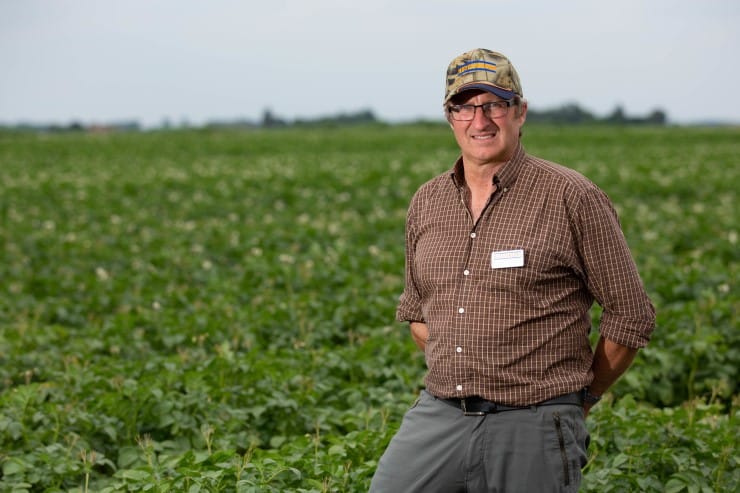Alternating modes of activity essential to blight programmes – Arable Farming
Hutchinsons' root crop technical manager Darryl Shailes talks through disease management for potatoes and sugar beet ...
The water has finally gone back down to normal levels, and we’ve been able to get onto the grass and cut it a few times. As the soil has dried and the weather warmed up it has really started to grow, so sitting on the mower will become a regular feature over the next few months.
The Waveney Valley is a bit like the Nile flood plane, and the amount of soil and nutrients that have been washed off the local arable fields, combined with the relatively high water table managed by the various sluices, ensures there is ample grazing for the local farmers.
Our little veg patch was also flooded on numerous occasions, so we will be looking for some bumper yields if the weather plays ball.
The only downside of the water going back down is that we probably won’t see kingfishers sitting on the washing line again for a while.
The warm winter has triggered the Rothamsted virus yellows model, and this has allowed the use of Cruiser SB on sugar beet in England. This should keep the treated fields free of aphids for about 10 weeks and be a good start to the virus management programme for the season.
The non-treated crops could be a challenge as the aphids were predicted to start migrating around April 10, which is 10 days before the migration was in 2023. With the wet weather delaying sugar beet drilling in many areas, the beet could potentially be emerging to a storm of aphids.
The recent report from Rothamsted of a neonicotinoid-resistant mysus persicae in Suffolk is also of concern, although at present it is only one clone among many millions. There is new chemistry on the horizon, but for now we must manage with what we have and everything we can do in terms of rotational hygiene; resistance management, observation of thresholds and timing of applications are all especially important. Mysus persicae is also a transmitter of virus in potatoes, and virus management is essential in seed crops, with aphicides being an essential component of control. However, in ware crops the need for intervention is less frequent as aphid populations often crash before they become a problem, so we must ensure we observe established thresholds before any treatment.
Sugar beet
Weed control is always very important in sugar beet, and the recent introduction of Conviso Smart technology has simplified weed management – especially weed beet – for many growers.
However, the technology must be managed effectively. There have been instances of ALS resistance reported in some sugar beet fields, and I’ve seen a photo of some very vigorous poppies in a field only treated with Conviso One (foramsulfuron+thiencarbazone- methyl) where the poppies were ALS-resistant.
While this is not an issue of Conviso One per se, but instead of rotational management of herbicides, we must be aware of it and bring some conventional chemistry into the system to manage this potential resistance.
Another challenge with the Conviso Smart system is ground keeper management, so this must be considered when introducing this excellent technology onto farms.
Potato planting
Potato plantings have also been delayed by the wet weather, and as much as it is good to get them in as early as possible, we saw as recently as 2023 that crops planted a bit later into good soil conditions outper- formed those planted earlier into compromised ones.
Weed control is generally less of a challenge in potatoes, but we must consider soil type and variety when thinking about our residual programmes.
We only have a limited amount of post-emergent herbicides with varietal challenges, and as a business Hutchinsons has been investing in trials to evaluate newer varieties and their herbicide tolerance at our trial and demo sites.
When we get into the challenge of blight and other foliar disease, resistance raises its head.
As we discussed in March, there are blight clones with confirmed resistance in phytoph- thora infestans of some of the commonly used actives in our blight programmes.
We have at least one more season of mancozeb, which is a great component of an anti resistance programme as it’s a multisite with no known resistance.
Modern blight fungicides are much more targeted in the life cycle of blight, and while being very effective, single site activity enables resistance to develop if they are not managed effectively.
Unfortunately, the regulators don’t seem to take a good resistance management programme into
consideration with approvals, so it is down to us to manage actives.
While we don’t currently have CAA- or OXTP-resistant clones causing problems in the UK, alternating different modes of activity will be essential in blight programmes going forward – including using mancozeb for as long we are allowed.
Mancozeb is also very useful in managing alternaria in potatoes. Alternaria also has challenges with resistance, with both the strobilurins and older SDHIs having resistant strains.
As far as I’m aware, there is no resistance to triazole in alternaria, so a good programme should have both triazole and one of the newer SDHIS where needed.
There is a long way to go in both crops, so it will be interesting to see what the season brings.
